Family : Scaridae

Text © Giuseppe Mazza

English translation by Mario Beltramini
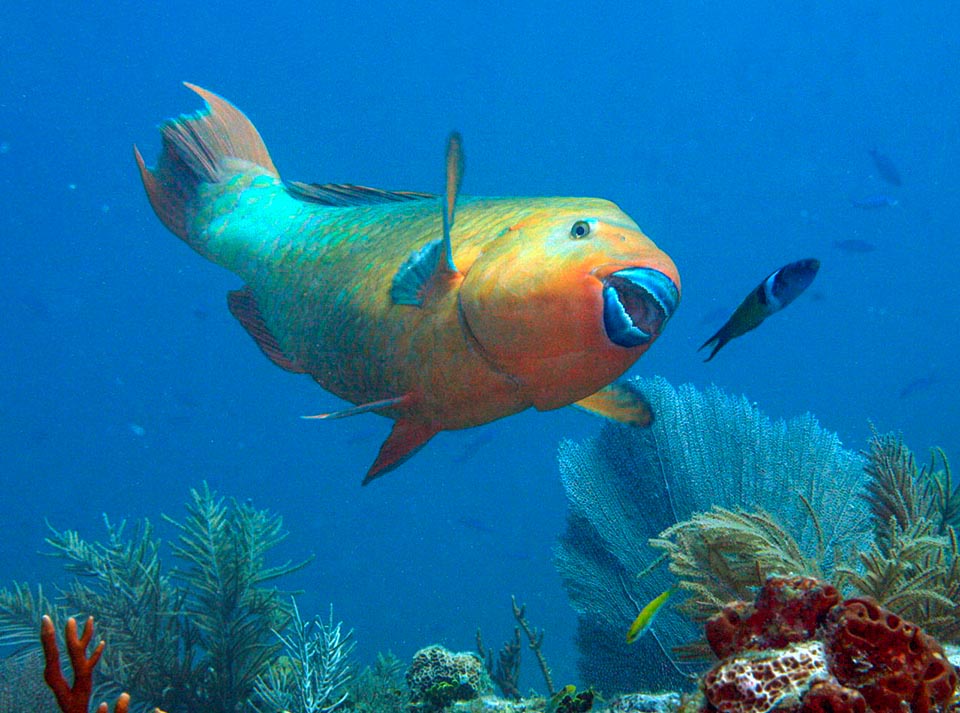
With a vast distribution in western Atlantic, Scarus guacamaia can be 120 cm long and is the biggest herbivorous fish in the Caribbean © Kevin Bryant
The Rainbow parrotfish (Scarus guacamaia Cuvier, 1829) belongs to the class of the Actinopterygii, the ray-finned fishes, to the order of the Perciformes and to the multi-coloured family of the Scaridae, the parrotfishes, counting about ten genera and about hundred species.
The etymology gets its origin from the vulgar names: Scarus in Latin indicates, as well as in Greek “σκάρος” (skáros), an edible fish of the Mediterranean, whilst guacamaia is the Latinization of “guacamaya”, the name with which the Cubans call this fish, that is, after all, the name with which the Spaniards use for the Ara macaws, characterized, they too, by a huge beak and bright colours.
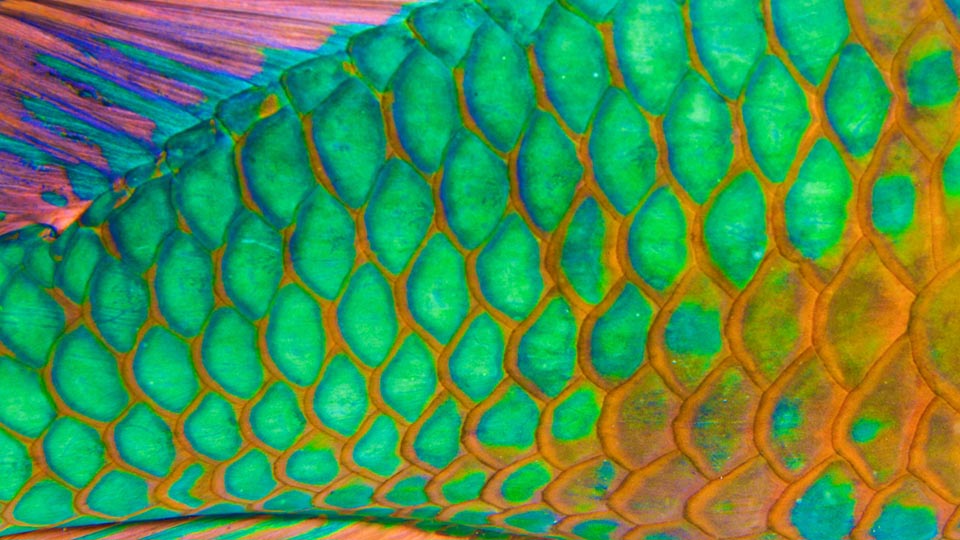
The big multicoloured scales have valued it, rightly, the name of Rainbow parrotfish © Allison & Carlos Estape
Zoogeography
The Rainbow parrot fish has a very vast distribution in the tropical waters of the western Atlantic.
Indicatively, starting from Bermuda, we find it in Florida, in the Bahamas, in the Turks and Caicos Islands, Cuba, Belize, Guatemala, Honduras, Nicaragua, Costa Rica, Panama, Cayman Islands, Jamaica, Haiti, Dominican Republic, Puerto Rico and in all islands of the Caribbean Sea up to Colombia, Venezuela, Guyana and Suriname, then going down along the coasts of Brazil up to Argentina. It is absent only in the northern part of the Gulf of Mexico.
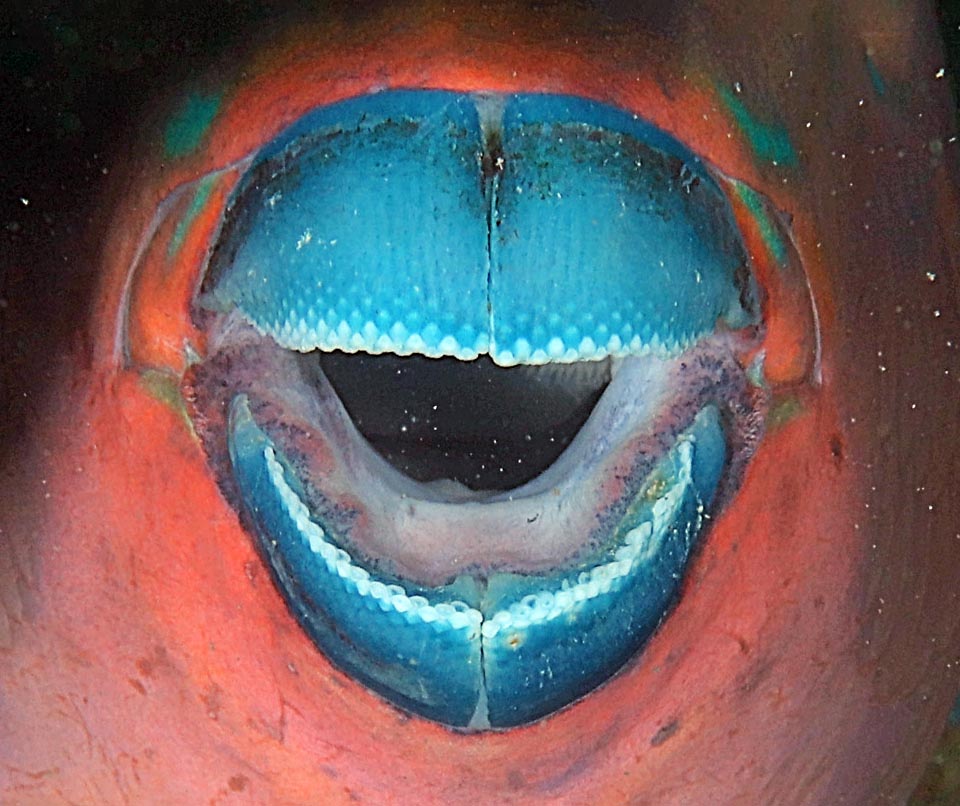
Like the Ara macaws it has a big strong beak formed by the fused together incisors forming two solid greenish blue plates with serrate margin © Kevin Bryant
Ecology-Habitat
Scarus guacamaia goes swilling in relatively shallow waters, between 3 and 25 m of depth. It lives in madreporic environments, but also in the seagrass meadows and on the sandy bottoms, that it feeds gnawing all day the old madrepores infested by encrusting algae. It takes them off with its beak, swallowing them with part of the substratum and grinds them for a long time, thanks to the pharyngeal teeth, to aid their digestion. In this way, in fact, it is a very important producer of coral sand.
Conversely, the young grow up among the roots of the mangroves, an indispensable environment for their reproduction and their survival. In fact, where these formations have been disturbed by man, the Rainbow parrotfish has disappeared or is in strong decrease.
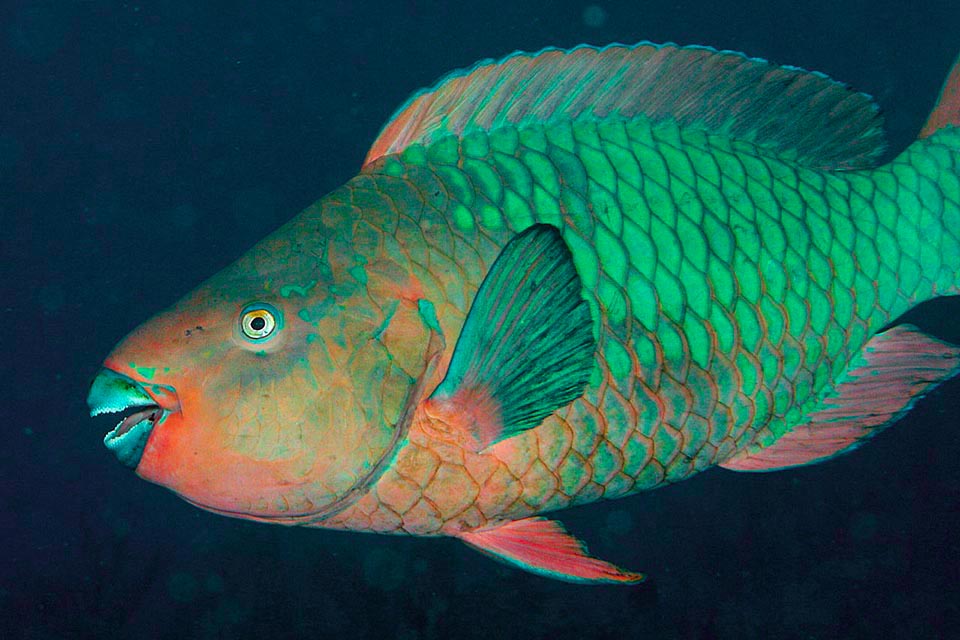
Moreover the mouth, inside, is covered by pharyngeal teeth, similar to molars, arranged in more rows © Kevin Bryant
Morphophysiology
Albeit its normal size is about 70 cm, Scarus guacamaia can reach the length of 120 cm and 20 kg of weight and is the biggest herbivorous fish in the Caribbean.
The beak is formed by the incisors, fused together on both jaws to form two enormous solid greenish blue plates with serrated edges, and the pharyngeal teeth, like molars, arranged in more rows. The thing had not escaped Aristotle who, talking of a Mediterranean parrotfish, the Sparisoma cretense, considered it, as is the case for the bovines, a “ruminant fish”.
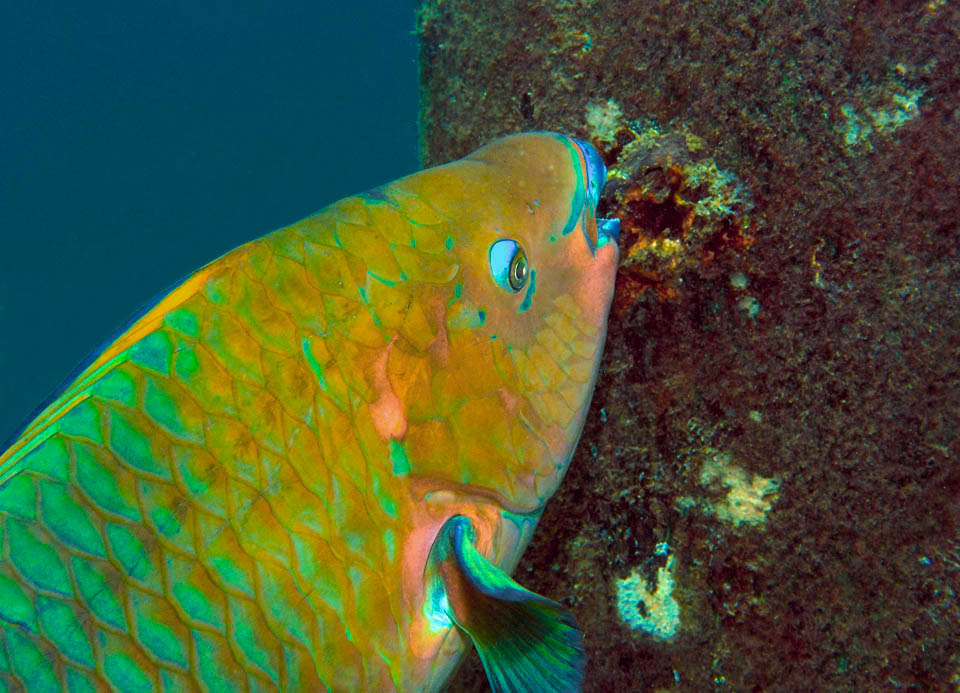
Here at work. It scrapes at the root the encrusting algae and grinding them with the substratum is also an important maker of coral sand © Pauline Walsh Jacobson
Scarus guacamaia has a robust body, fusiform with big scales. There is only one dorsal fin with 9 spiny rays and 10 softs. The anal, shorter, has 3 spiny rays and 9 unarmed and the pectoral ones 16 soft rays. The pelvic are triangular and the powerful caudal fin, truncated in the young, is elongated at the centre and especially on the sides in the senior specimens.
There is not an evident sexual dimorphism, but the colour and at times the sex change with age. It can be said that during their growth these fishes pass through three phases. The first is the juvenile one, with a greyish livery. In the second, with moderate tones, the colours appear. Males and females, sexually mature, have the same look: showy liveries where are not missing, in elegant combinations, the red, the orange, the green, the blue and the turquoise.
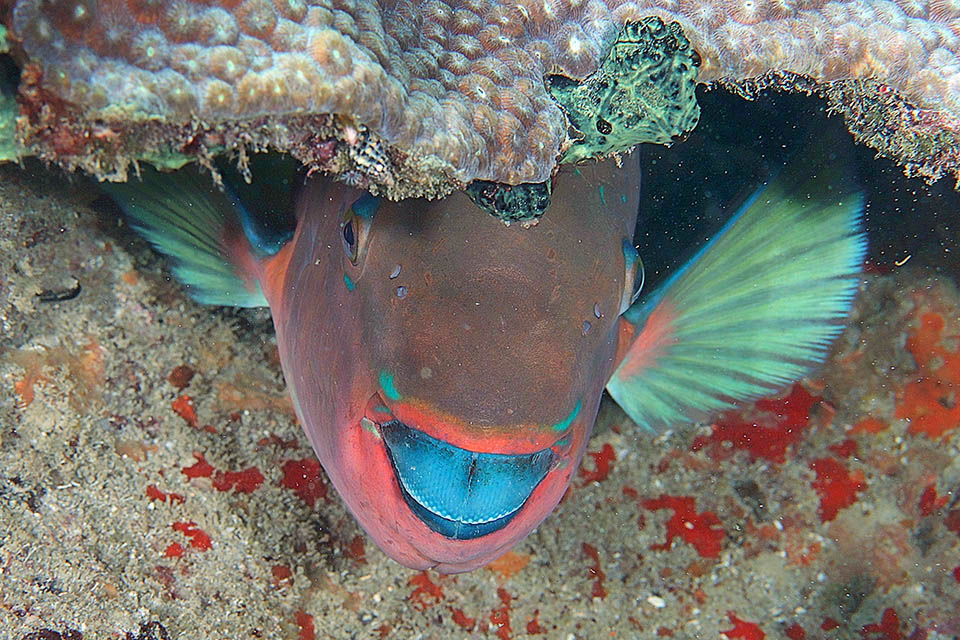
It’s a diurnal animal that every evening, after grazing, goes to its den orienting with the sun. A safe abode where it spends the night and shelters quickly in case of danger © Kevin Bryant
During the third phase, the dominant males are distinguished for their imposing size and more intense and stronger colours, with the head, the fins and the fore part of the body tending to dark red and what remains to green or turquoise.
They can be as such from the birth or females that have changed sex because the dominant male, who controlled a small harem driving out the competitors, has passed away. It is up to it to fecundate in turn the females ready to lay, even if at times some smart boys, disguised ad females with a deliberately inconspicuous livery, sneak into the harem to emit, furtively, their gametes on the eggs dispersed by the current.
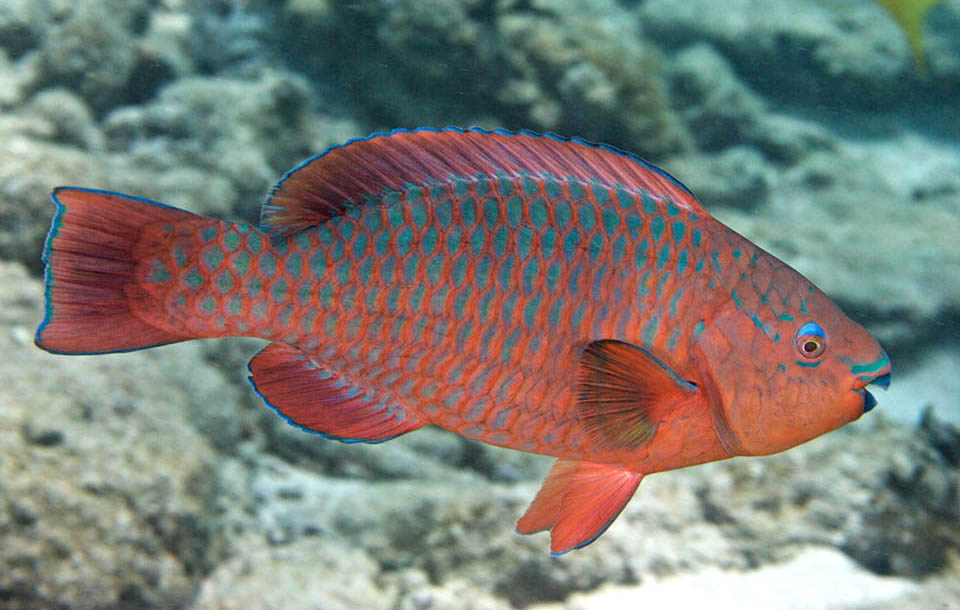
Livery does not display a clear sexual dimorphism, but colour and at times also sex change with the age © Allison & Carlos Estape
In this way, even if the fecundation is however a fact of the couple, the progeny is in the same time fecundated “ad maiora” by the strongest smarter individual.
Ethology-Reproductive Biology
The Rainbow parrotfish nourishes almost exclusively of the algae that encrust the old madrepores, but it has been seen also cleaning the jetties nibbling the sponges.
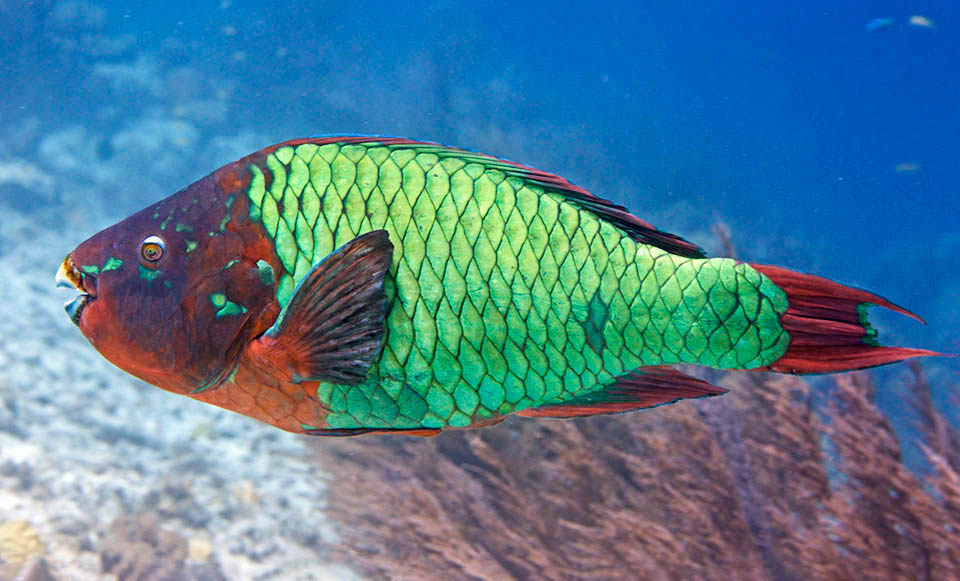
Initially the livery is greyish, then colours get out, and finally the fore part of the body tends to dark red and the rest to green or to turquoise © Allison & Carlos Estape
It is a diurnal animal that every evening, after grazing, gets back to its den orienting itself with the sun. A safe abode where it spends the night and towards where it runs to take refuge in case of danger.
The deposition, in mid-water, usually takes place where the currents head towards the mangroves formations that offer larvae and small fishes a safe shelter, far away from predators and rich in food resources.
The juveniles grow up, most exclusively, among the roots of these plants that they leave starting from the 10 cm of length, with a lifespan of about 20 years.
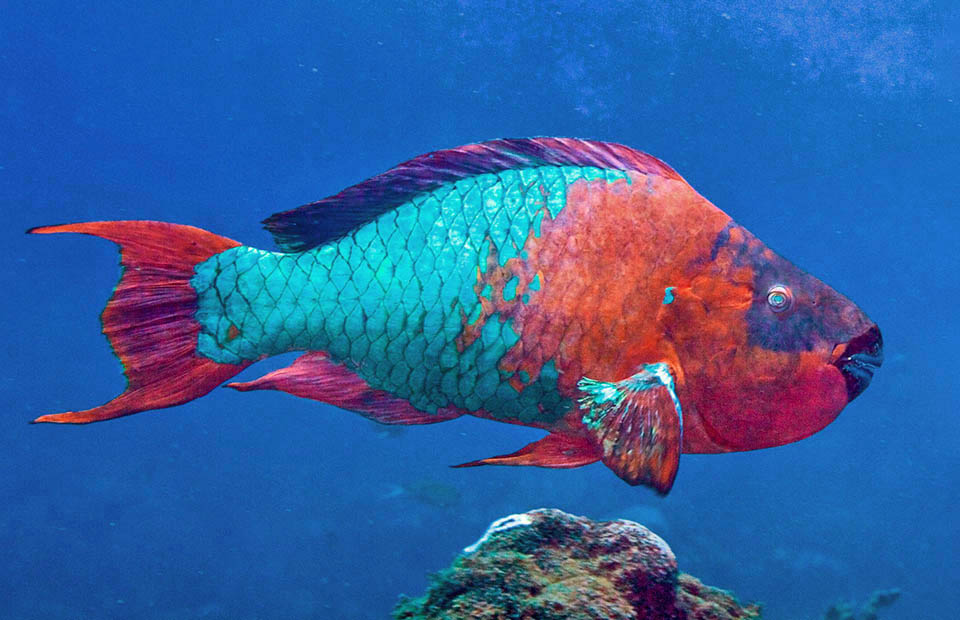
They live in small schools with one dominant male of imposing size controlling a small harem and fecundating the female on duty © Allison & Carlos Estape
So, the further we get from the mangrove forests, the more the number of the Rainbow parrotfishes decreases, but in return they increase their size. Offshore we do not find individuals shorter than 20 cm and the biggest specimens at times go swimming in faraway reefs, even 40 km far.
Although splendid, Scarus guacamaia is not hunted as aquarium fish. Given the size, it might be theoretically hosted by the large public aquaria, but without a continuous renewal of madrepores encrusted by algae to scrape, the merged teeth forming the beak would inevitably grow out of proportion compromising their existence.
Conversely, the Rainbow parrotfish is locally fished for the local consumption, even if in some locations or seasons, depending on the algae it nibbles, its flesh may aver toxic, at risk of ciguatera, a serious food poisoning.
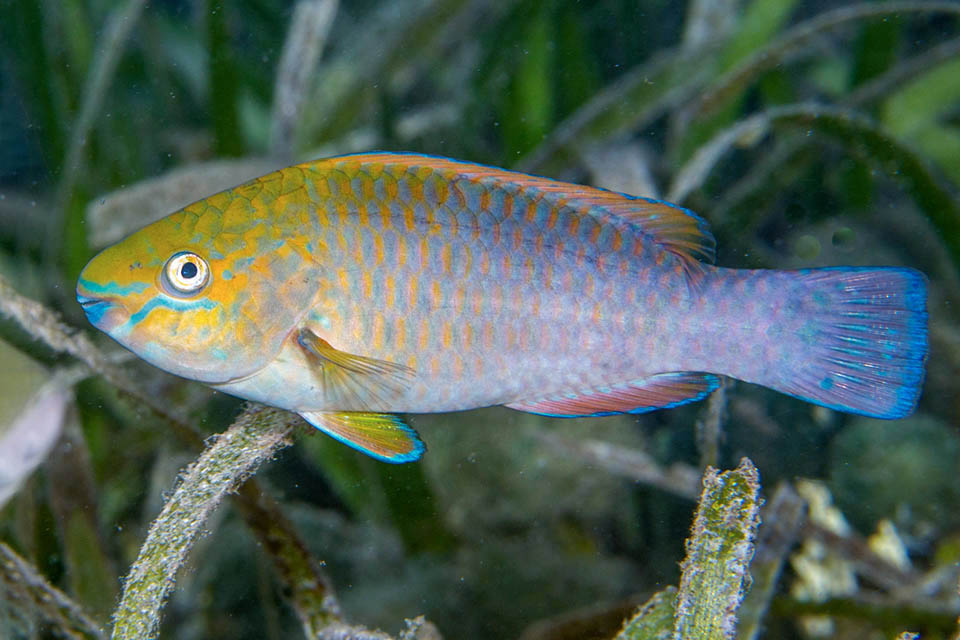
Juvenile beginning to colour. The small fishes grow up among the mangroves roots and where these disappear the species decreases quickly © Allison & Carlos Estape
The resilience of the species is fair with a possible doubling of the populations in 1.4-4.4 years and the vulnerability index to fishing is moderate, marking 42 on a scale of 100, but where the mangroves have disappeared due to urbanization or oil exploration the populations of Scarus guacamaia are in sharp decline and since 2012 it has therefore been listed as “NT, Near Threatened” in the IUCN Red List of endangered species.
Synonyms
Scarus turchesius Valenciennes, 1840; Scarus pleianus Poey, 1861.
→ For general information about FISH please click here.
→ For general information about BONY FISH please click here
→ For general information about CARTILAGINOUS FISH please click here.
→ To appreciate the BIODIVERSITY of BONY FISH please click here.
→ To appreciate the BIODIVERSITY of CARTILAGINOUS FISH please click here.
